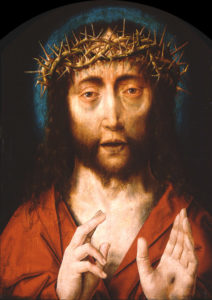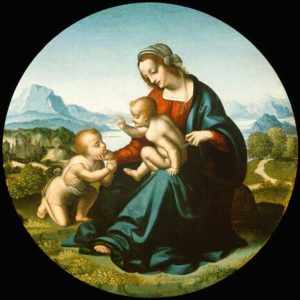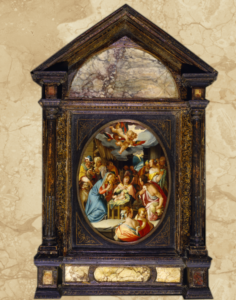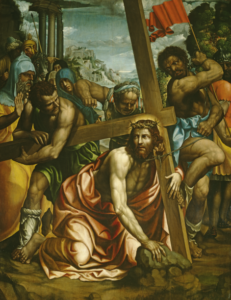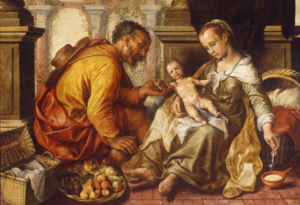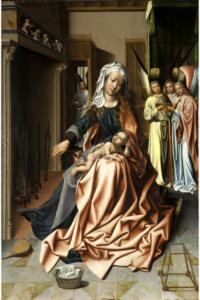Madonna and Child with Saints
Tempera on panel, 1469
Baldassare di Biagio del Firenze (called the Master of Benabbio) and Matteo Civitali
Biago: Florentine, c. 1450-1500; Civitali: Luccan, c. 1436-1501
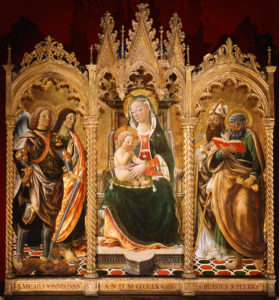
Paintings dating to the fourteenth and fifteenth centuries present an inherent obstacle—attribution, since artists were not consistently signing works prior to the nineteenth century. To compound the problem, many artists up until the mid-1400s painted in a similar manner, not especially concerned with individual styles and expression. When art experts are unable to associate an unsigned painting with a particular known master painter, a pseudonym is derived from the name of the place where the most characteristic work of the unknown artist resides.
In the case of this painting, the artist was known as the “Master of Benabbio” when we acquired the painting in 1961. This unknown artist’s best representative work was a triptych that belongs to the church of Santa Maria Assunta in the small, Tuscan village of Benabbio, Italy; hence the unknown artist was dubbed “Master of Benabbio.”
Scholars who research and distinguish authorship for unsigned paintings specialize in a particular field of study; their specialization usually focuses on a particular country and time period but may also narrow further to a particular region or city. This concentration allows the scholar to review closely the nuances of artists’ particular styles working in a certain time and place, honing the skill of art connoisseurship.
Another facet of researching authorship for Old Master paintings involves documentary evidence. Scholars using archives comb through original documents (often dating hundreds of years old) looking for clues that will allow them to piece together information for a known work of art. In 1978 one such art historian, Massimo Ferretti, defined the career and primary works of the “Master of Benabbio.” Ferretti connected M&G’s painting with a citation in Michele Ridolfi’s 1819 publication of a sixteenth century inventory of the church of San Michele in Antraccoli (near Lucca) which said, “In the Oratory of the Company next to the church there is an old altar of wood in Gothic ‘gusto,’ in the panels of which is represented the Virgin and Child, and the four saints, and in the predella below the twelve apostles; it is a work of the Florentine School of uncertain author, and bears a date of the year 1469.” Since the artist’s name was not mentioned in this inventory, he continued to be known under the pseudonym, “Master of Benabbio.”
The inventory’s date of 1469 corresponds exactly to the date that is written in Roman numerals across the base of the triptych. Furthermore, the prominent presence of St. Michael the Archangel on the left side of the painting supports its position as the main altar of a church dedicated to this same saint, San Michele.
Subsequent archival research by Roberto Ciardi in 1997 led to the discovery of the original contract when this altarpiece was commissioned by Antonio del fu Domenico and Biagio del fu Tofanello for the Church of San Michele di Antraccoli. The contract says on December 15, 1467, Antonio del fu Domenicho and Biagio del fu Tofanello, operai (workers), sindici, e procuratori (prosecutors) dell’opera (of the work) di San Michele di Antraccolo, commissioned “Valdassar olim Bazii del Firenze, lucensis civis et Matteus olim Johnnis di Coviatlie, Luce commorans, pictures,” to paint a ‘tabulam de lignamine’ for the high altar of San Michele within ten months for seventy ducats. The artists were to begin in January 1468 and to complete the painting in ten months. However, the altarpiece was not delivered until October 6, 1469—twenty months later.
Documentation such as this provides concrete evidence for the attribution of this altarpiece to not one, but two prominent Luccan artists of the Italian Renaissance—Baldassare di Biagio del Firenze and Matteo Civitali. For centuries it was thought that only one artist, provisionally called “Master of Benabbio,” was responsible for the painting. However, the contract revealed that the painting was actually a collaborative effort, which was not unusual for this time period or for these artists. The importance is in the firm identification of the artists.
The significance for Baldassare is that this is one of the few altarpieces of his where the original church context is known. Furthermore, his artistic personality is still in its infancy because until 1982, the artist’s works were only known by the elusive pseudonym, Master of Benabbio. A secure attribution and dating for this altarpiece make it a benchmark for judging undocumented works thought to be by him.
As for Matteo Civitali, the documentation for this altarpiece is paramount. Until 1997, Matteo Civitali’s acclaim rested wholly on his work as a sculptor. He is considered to be the most important marble sculptor outside Florence during the second half of the fifteenth century. In spite of his fame as a carver, historical evidence pointed to his activity as a painter as well, though no painting could firmly be identified. Before the revelation of the contract for our polyptych identifying him as a collaborator, the extent of his painting activity was only surmised. Now M&G’s polyptych has become a key work for Civitali’s career as a painter. In 2004, this polyptych traveled to the Villa Giunigi in Lucca, Italy for an important monographic exhibition focused on the career of Matteo Civitali.
John M. Nolan, Curator
Published in 2014
